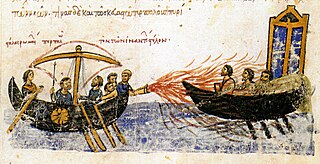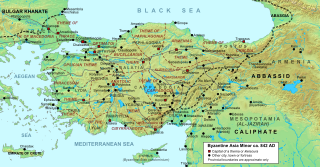
This is a list of Byzantine inventions. The Byzantine or Eastern Roman Empire represented the continuation of the Roman Empire after a part of it collapsed. Its main characteristics were Roman state traditions, Greek culture and Christian faith. [2]

This is a list of Byzantine inventions. The Byzantine or Eastern Roman Empire represented the continuation of the Roman Empire after a part of it collapsed. Its main characteristics were Roman state traditions, Greek culture and Christian faith. [2]

A catapult is a ballistic device used to launch a projectile a great distance without the aid of gunpowder or other propellants – particularly various types of ancient and medieval siege engines. A catapult uses the sudden release of stored potential energy to propel its payload. Most convert tension or torsion energy that was more slowly and manually built up within the device before release, via springs, bows, twisted rope, elastic, or any of numerous other materials and mechanisms.

Greek fire was an incendiary chemical weapon manufactured in and used by the Eastern Roman Empire from the seventh through the fourteenth centuries. The recipe for Greek fire was a closely-guarded state secret, but historians speculate it may have been made by combining pine resin, naphtha, quicklime, calcium phosphide, sulfur, or niter. Roman sailors would toss grenades loaded with Greek fire onto enemy ships or spray it from tubes. Its ability to burn on water made it an effective and destructive naval incendiary weapon, and rival powers tried unsuccessfully to copy the material.

A trebuchet is a type of catapult that uses a rotating arm with a sling attached to the tip to launch a projectile. It was a common powerful siege engine until the advent of gunpowder. The design of a trebuchet allows it to launch projectiles of greater weights and further distances than that of a traditional catapult.

The mangonel, also called the traction trebuchet, was a type of trebuchet used in Ancient China starting from the Warring States period, and later across Eurasia by the 6th century AD. Unlike the later counterweight trebuchet, the mangonel operated on manpower-pulling cords attached to a lever and sling to launch projectiles.

A dromon was a type of galley and the most important warship of the Byzantine navy from the 5th to 12th centuries AD, when they were succeeded by Italian-style galleys. It was developed from the ancient liburnian, which was the mainstay of the Roman navy during the Empire.

The Byzantine navy was the naval force of the Byzantine Empire. Like the state it served, it was a direct continuation from its Roman predecessor, but played a far greater role in the defence and survival of the state than its earlier iteration. While the fleets of the Roman Empire faced few great naval threats, operating as a policing force vastly inferior in power and prestige to the army, command of the sea became vital to the very existence of the Byzantine state, which several historians have called a "maritime empire".

Byzantine medicine encompasses the common medical practices of the Byzantine Empire from c. 400 AD to 1453 AD. Byzantine medicine was notable for building upon the knowledge base developed by its Greco-Roman predecessors. In preserving medical practices from antiquity, Byzantine medicine influenced Islamic medicine and fostered the Western rebirth of medicine during the Renaissance.
Michael Angold is Professor Emeritus of Byzantine History and Honorary Fellow at the University of Edinburgh.

Scientific scholarship during the Byzantine Empire played an important role in the transmission of classical knowledge to the Islamic world and to Renaissance Italy, and also in the transmission of Islamic science to Renaissance Italy. Its rich historiographical tradition preserved ancient knowledge upon which splendid art, architecture, literature and technological achievements were built. Byzantines stood behind several technological advancements.

This article lists and briefly discusses the most important of many military treatises on military science produced in the Byzantine Empire.

Byzantine studies is an interdisciplinary branch of the humanities that addresses the history, culture, demography, dress, religion/theology, art, literature/epigraphy, music, science, economy, coinage and politics of the Eastern Roman Empire. The discipline's founder in Germany is considered to be the philologist Hieronymus Wolf (1516–1580), a Renaissance Humanist. He gave the name "Byzantine" to the Eastern Roman Empire that continued after the Western Roman Empire collapsed in 476 AD. About 100 years after the final conquest of Constantinople by the Ottomans, Wolf began to collect, edit, and translate the writings of Byzantine philosophers. Other 16th-century humanists introduced Byzantine studies to Holland and Italy. The subject may also be called Byzantinology or Byzantology, although these terms are usually found in English translations of original non-English sources. A scholar of Byzantine studies is called a Byzantinist.

The Byzantine Empire, also referred to as the Eastern Roman Empire, was the continuation of the Roman Empire centered in Constantinople during Late Antiquity and the Middle Ages. The eastern half of the Empire survived the conditions that caused the fall of the West in the 5th century AD, and continued to exist until the fall of Constantinople to the Ottoman Empire in 1453. During most of its existence, the empire remained the most powerful economic, cultural, and military force in the Mediterranean world. The term "Byzantine Empire" was only coined following the empire's demise; its citizens referred to the polity as the "Roman Empire" and to themselves as "Romans". Due to the imperial seat's move from Rome to Byzantium, the adoption of state Christianity, and the predominance of Greek instead of Latin, modern historians continue to make a distinction between the earlier Roman Empire and the later Byzantine Empire.

Byzantine rhetoric refers to rhetorical theorizing and production during the time of the Byzantine Empire. Byzantine rhetoric is significant in part because of the sheer volume of rhetorical works produced during this period. Rhetoric was the most important and difficult topic studied in the Byzantine education system, beginning at the Pandidakterion in early fifth century Constantinople, where the school emphasized the study of rhetoric with eight teaching chairs, five in Greek and three in Latin. The hard training of Byzantine rhetoric provided skills and credentials for citizens to attain public office in the imperial service, or posts of authority within the Church.
Nasar, originally baptized Basil, was a distinguished Byzantine military leader in the Byzantine–Arab conflicts of the latter half of the 9th century.

The mesazon was a high dignitary and official during the last centuries of the Byzantine Empire, who acted as the chief minister and principal aide of the Byzantine emperor. In the West, the dignity was understood as being that of the imperial chancellor.
The Karabisianoi, sometimes anglicized as the Carabisians, were the main forces of the Byzantine navy from the mid-seventh until the early eighth centuries. The name derives from a term for ships, and means "people of the ships". The Karabisianoi were the first new and permanent naval establishment of the Byzantine Empire, formed to confront the early Muslim conquests at sea. They were disbanded and replaced with a series of maritime themes sometime in 718–730.

The Cibyrrhaeot Theme, more properly the Theme of the Cibyrrhaeots, was a Byzantine theme encompassing the southern coast of Asia Minor from the early 8th to the late 12th centuries. As the Byzantine Empire's first and most important naval theme, it served chiefly to provide ships and troops for the Byzantine navy.

The Battle of Kardia was a naval battle fought in c. 872/3 between the fleets of the Byzantine Empire and the Cretan Saracens off Kardia, in the Gulf of Saros. The battle was a major Byzantine victory.

The siege of Euripos occurred in the mid-880s, when an Abbasid fleet, led by the emir of Tarsos, Yazaman al-Khadim, laid siege to the city. The local Byzantine commander, Oiniates, successfully defended the city and destroyed a large part of the besieging force.

The torsion mangonel myth, or simply the myth of the mangonel, is the belief that mangonels were torsion siege engines such as the ballista or onager which used the tension effect of twisted cords to shoot projectiles. Despite a significant body of research dating as far back as the 19th century pointing to the contrary, "it has not stopped the transmission of the myth to the present day." Evidence for the usage of torsion siege weapons, with the exception of the springald, exist only up until the 6th century, when they were superseded by the traction trebuchet, more commonly known as the mangonel.
{{citation}}: CS1 maint: location missing publisher (link){{citation}}: CS1 maint: location missing publisher (link)